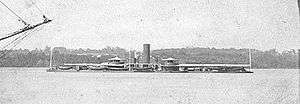USS Tonawanda (1864)
 The USS Tonawanda in the Severn River serving as a training ship in the late 1860s. | |
| History | |
|---|---|
| Name: | USS Tonawanda |
| Builder: | Philadelphia Navy Yard |
| Laid down: | 1862 |
| Launched: | 6 May 1864 |
| Commissioned: | 12 October 1865 |
| Decommissioned: | 22 December 1865 |
| Recommissioned: | 23 October 1866 |
| Decommissioned: | 1872 |
| Renamed: | USS Amphitrite, 15 June 1869 |
| Fate: | Broken up, 1874 |
| General characteristics | |
| Class and type: | Miantonomoh-class monitor |
| Displacement: | 3,400 long tons (3,455 t) |
| Length: | 258 ft 6 in (78.79 m) |
| Beam: | 52 ft 9 in (16.08 m) |
| Draft: | 14 ft (4.3 m) |
| Propulsion: |
|
| Speed: | 10.5 knots (19.4 km/h; 12.1 mph) |
| Complement: | 150 officers and men |
| Armament: | 4 × 15 in (380 mm) smoothbore Dahlgren guns (2×2) |
| Armor: |
|
USS Tonawanda was a double-turreted coastal monitor built by the Philadelphia Navy Yard, launched on 6 May 1864; and commissioned on 12 October 1865, Commander William Ronckendorff in command.
The Tonawanda was designed by Chief of Naval Engineering John Lenthall. Lenthall actually designed four monitors at that time. The Monadnock and the Agamenticus were the first and are considered the two Monadnock-class vessels. Lenthall altered the designs of the next two, the Miantonomoh and the Tonawanda and dubbed them the Miantonomoh-class. Because of the similarities between the two classes they are sometimes referred to collectively as the Miantonomoh-class.
The Tonawanda used powerful steam engines designed by Chief of Steam Engineering, Benjamin F. Isherwood. Her hull design was also much more streamlined than monitors designed by John Ericsson. Unfortunately, her internal frames were only 4.5 in oak and like Lenthall's Roanoke conversion, the weight of her turrets weakened the structural integrity of the hull and she was prone to rotting and cracking.
Service history
Completed too late for service in the Civil War, Tonawanda was decommissioned at the Washington Navy Yard on 22 December 1865. Reactivated on 23 October 1866 for duty as a training ship at the United States Naval Academy, she was serving in that capacity when she was renamed Amphitrite on 15 June 1869. Her assignment at Annapolis, MD ended in 1872, and she was taken to the Delaware River and broken up in 1873 and 1874 by the Harlan and Hollingsworth Co., Wilmington, DE under the guise of being "rebuilt" into a modern monitor. The completely new monitor that replaced her was also named Amphitrite, but shared nothing but the name with the older ship.
References
- This article incorporates text from the public domain Dictionary of American Naval Fighting Ships. The entry can be found here.
- Canney, Donald L. (1993). The Old Steam Navy: The Ironclads, 1842–1885. 2. Annapolis, Maryland: Naval Institute Press. ISBN 0-87021-586-8.
- Olmstead, Edwin; Stark, Wayne E.; Tucker, Spencer C. (1997). The Big Guns: Civil War Siege, Seacoast, and Naval Cannon. Alexandria Bay, New York: Museum Restoration Service. ISBN 0-88855-012-X.
- Silverstone, Paul H. (2006). Civil War Navies 1855-1883. The U.S. Navy Warship Series. New York: Routledge. ISBN 0-415-97870-X.